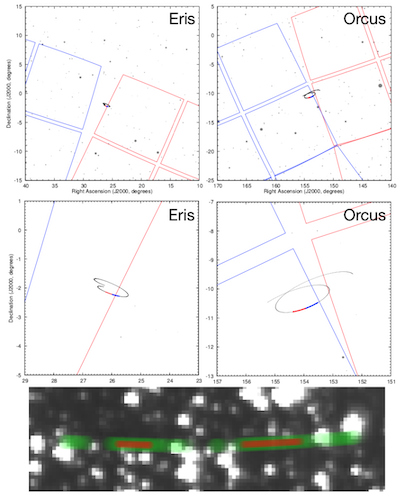Dwarf planet light curves with TESS
- 1Konkoly Observatory, Research Center for Astronomy and Earth Sciences, Budapest, Hungary (pkisscs@konkoly.hu)
- 2ELTE Eötvös University, Institute of Physics, Budapest, Hungary
- 3Max-Planck-Institut für extraterrestrische Physik, Garching, Germany
Despite that they are the brightest representatives of trans-Neptunian objects, many dwarf planets still miss a well-determined light curve and hence rotation period, in many cases due to the biases and aliases of ground-based observations. As it was previously shown in the case of e.g. Gonggong (2007 OR10), one of the largest Kuiper belt objects known, a well determined rotation period can be deduced from light curve data obtained by space surveys with original goals very different from the observations of Solar system objects (Pál et al., 2016; Kiss et al., 2017). In the case of Gonggong the observations were taken in the framework of the K2 mission of the Kepler Space Telescope (Howell et al., 2014) which was initially dedicated to measure exoplanet transits. However, in its K2 mission the telescope was pointed to the ecliptic, and allowed the long, in some cases up to ~80 day measurements of small solar system bodies, resulting in a previously undetected overabundance of long rotation periods in many of the small body populations, including the Hildas, Jovian Trojans, Centaurs, as well as trans-Neptunian objects (Kalup et al., 2021; Kiss et al., 2020; Marton et al., 2020; Szabó et al., 2017, 2020).
The Transiting Exoplanet Survey Satellite (TESS, Ricker et al., 2015) was also designed originally to find exoplanets and avoid the vicinity of the ecliptic. However, it was still able to observe many asteroid at intermediate ecliptic latitudes. While the maximum length of the TESS observations are shorter than those in the K2 mission (28 days vs. 80 days) these are still much longer than that a typical long observing campaign can provide from the ground. Recently, a large number of main belt asteroid light curves was obtained by TESS, leading to the discovery of a previously undetected group of slow rotators (Pál et al., 2020). Due to the smaller light collecting area most trans-Neptunian objects are too faint to be observed with TESS, but the largest ones -- the dwarf planets -- are bright enough to provide a meaningful light curve.
In this presentation we show results from the analysis of TESS light curves of the Kuiper belt dwarf planets Eris, Makemake and Orcus. These data are, in some cases, combined with ground-based data, and also with thermal emission measurements to constrain the spin axis orientation and determine how the light curve can be caused by surface features. As all the three targets have companions, the rotational information can also be incorporated into tidal evolution models and can be used to constrain the formation scenarios of the system, and, in some cases, give hints on the internal structure and material properties.

Figure 1: Right panels: The apparent path of Eris during the first year of the TESS observations just in between the boundaries of TESS Sectors #3 (red) and #4 (blue). During its retrograde motion, Eris just misses Camera #1, CCD #3 of Sector #3. The thin line shows the full path of Eris while the thick red and blue sections correspond to the observing runs of Sectors #3 and #4, respectively. Left panels: The same plot for Orcus and for TESS Sectors #8 (red) and #9 (blue). Orcus has been observed during Sector #9 by CCD #1 of Camera #1, pretty close to the CCD edges. Bottom panel: The apparent track of Orcus within the field of view of TESS Camera #1 CCD #1, section [44:144]x[1675:1705]. The semi-transparent green curve shows the full track where observations were available while the thin red curve shows the track from which data points were involved in the photometric analysis. The direction of this section with respect to the sky is mirrored (east is nearly to the right and north points nearly to up): Orcus moved from the left to right due to its retrograde motion at its opposition.
References:
- Howell, S.B., et al., 2014, PASP, 126, 398
- Kalup, C., et al., 2021, ApJS, 254, 7
- Kiss C., et al., 2017, ApJL, 838, L1
- Kiss, C., et al., 2020, EPSC2020-536
- Marton, G., et al., 2020, Icarus, 345, 113721
- Pál, A., et al., 2020, ApJS, 247, 26
- Ricker, G.R., et al. 2015, J. Astron. Telesc. Instrum. Syst. Vol. 1,id. 014003
- Szabó et al., 2017, A&A, 599, 44
- Szabó et al., 2020, ApJS, 247, 26
How to cite: Kiss, C., Farkas-Takács, A., Szakáts, R., Müller, T., and Pál, A.: Dwarf planet light curves with TESS, European Planetary Science Congress 2021, online, 13–24 Sep 2021, EPSC2021-123, https://doi.org/10.5194/epsc2021-123, 2021.

